As attention spans shrink and inboxes overflow, traditional lead-generation methods like cold calling and email outreach are becoming increasingly less effective. Savvy B2B companies are now turning to conversational AI to ignite interest and drive quality conversions at scale.
Recent surveys show over 62% of businesses have implemented chatbots for lead generation with high satisfaction scores. Key reasons include 24/7 qualification, providing faster sales cycles higher prospect engagement, and boosting lead quality.
According to Statista, by 2025, chatbots could influence around 15% of total B2B order value as personalized recommendations drive higher spending. Early leader use cases show chatbots capturing promising contacts, initiating needs analyses, scheduling demos, and accelerating sales hand-offs - all within engaging conversational flows.
With rich messaging interfaces, timely insights, and integrated workflows, chatbots are the next frontier for lead gen. As more brands pilot AI assistants, choosing solutions purpose-built for converting prospects at scale becomes crucial. We will explore specialized lead gen chatbot capabilities and top platforms enabling B2B success in this deep dive.
Why Chatbots for Lead Generation?
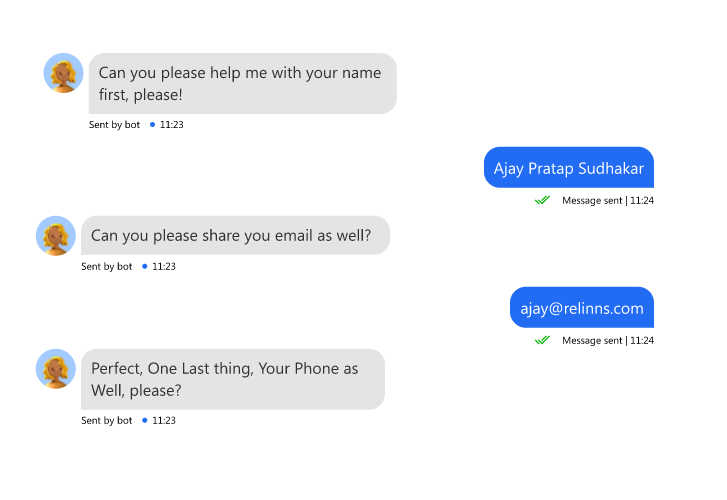
Chatbots have become increasingly popular for lead generation in recent years. With advancements in artificial intelligence and natural language processing, chatbots have become powerful tools for interacting with website visitors and capturing valuable leads. In this blog post, we will explore the benefits of using chatbots for lead generation and how they generate leads.
Benefits of Chatbots in Lead Generation

Using chatbots for lead generation offers several key benefits. These include:
- 24/7 Availability: Unlike human agents who have limited working hours, chatbots can operate round the clock, allowing businesses to capture leads at any time of the day.
- Instant Response: Chatbots provide instant responses to visitor inquiries, ensuring a positive user experience and increasing the likelihood of lead conversion.
- Scalability: Chatbots are capable of simultaneously handling multiple conversations, which makes them highly scalable for lead generation purposes. They can engage with numerous visitors simultaneously, significantly boosting lead generation potential.
- Qualification: Chatbots can qualify leads by asking specific questions and collecting relevant information. This enables businesses to gather valuable data about their potential customers and prioritize leads based on their potential value.
- Lead Nurturing: Through personalized conversations and tailored responses, chatbots can nurture leads by delivering relevant content and guiding them through the sales funnel. This helps in building stronger relationships with potential customers.
How Chatbots Work in Lead Generation?
Chatbots function by utilizing natural language processing algorithms. They analyze the user's query and provide appropriate responses based on pre-programmed rules or through machine learning techniques.
Here is a breakdown of the typical workflow of chatbot lead generation:
- User Engagement: Chatbots initiate conversations with website visitors through welcoming messages or offers of assistance to start lead generation
- Information Gathering: Chatbots ask questions to gather contact details, requirements, and other important data for leads
- Contextual Questions: Additional questions tailored to visitor needs and preferences provide chatbots with relevant context
- Qualification Questions: Assess potential lead value based on criteria set by the business to prioritize leads
- Lead Capture: Chatbots store gathered lead information in management systems or transfer it to sales teams
- Lead Nurturing and Conversion: Personalized content delivered by chatbots nurtures leads through sales funnel to increase conversions
- CRM Integration: Captured lead data integrated with customer relationship management platforms for organized lead handling
Types of Chatbots for Lead Generation
When it comes to using chatbots for lead generation, there are two main types to consider: rule-based chatbots and artificial intelligence (AI) chatbots. Each type has its unique features, benefits, and limitations.
Rule-based Chatbots
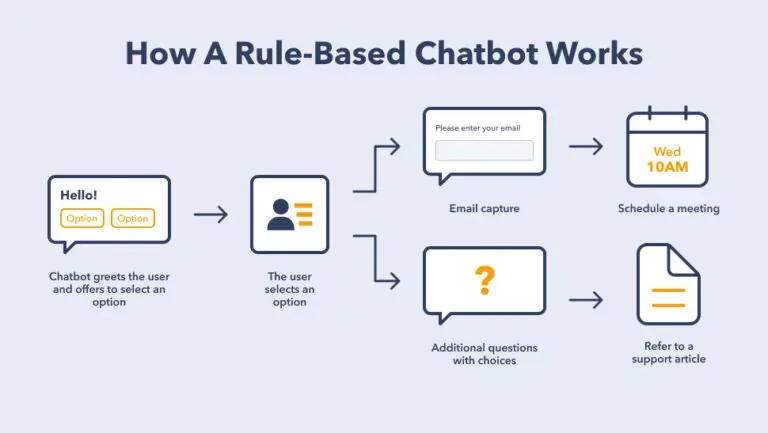
Rule-based chatbots are programmed with a set of predefined rules and responses. They follow a predefined flow and provide responses based on predetermined conditions or keywords. Here's an in-depth look at rule-based chatbots:
Rule-based chatbots rely on pre-programmed rules and decision trees to interact with users. They analyze the user's input and match it with predefined patterns to provide appropriate responses. These chatbots don't have machine-learning capabilities and operate based on a fixed set of rules.
Pros:
- Easy to implement and customize without extensive technical knowledge.
- Provide consistent and predictable responses.
- Can be designed to handle specific use cases effectively.
- Suitable for businesses with well-defined workflows and processes.
Cons:
- Limited ability to handle complex queries or understand user intent.
- Lack of adaptability and flexibility since predefined rules bind them.
- Require constant updates to accommodate new scenarios or user inputs.
- May result in repetitive or generic responses.
Effective Use Cases
- Lead Qualification: Rule-based chatbots can collect basic lead information, such as name, email, and phone number, helping businesses qualify leads based on predefined criteria.
- FAQ Assistance: These chatbots excel at answering frequently asked questions by providing predefined responses, reducing the workload on customer support teams.
- Appointment Scheduling: Rule-based chatbots can assist in scheduling appointments by guiding users through a predefined process and capturing relevant information.
Suggested Reading:
Artificial Intelligence (AI) Chatbots
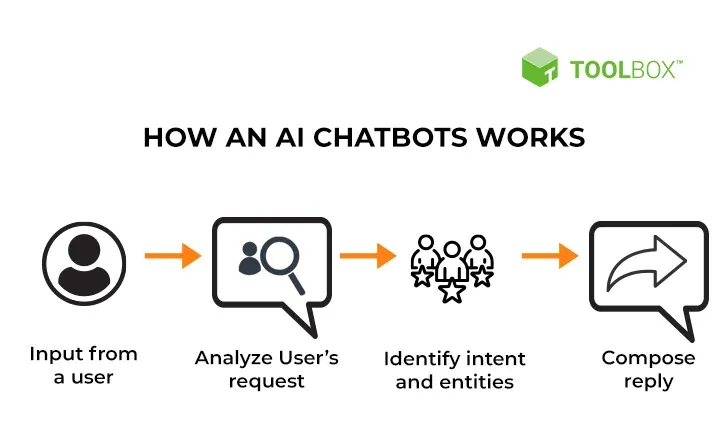
AI chatbots are designed to simulate human-like conversations and learn from user interactions.
Leveraging natural language processing and machine learning algorithms, these chatbots can understand intent, learn from data, and provide more intelligent and personalized responses.
AI chatbots use machine learning algorithms to process and understand natural language input. They learn and improve over time based on user interactions and data analysis.
Unlike rule-based chatbots, AI chatbots can handle more complex queries and understand the context to provide tailored responses.
Pros:
- Can understand and interpret complex user queries, resulting in more accurate and useful responses.
- Continuously learn and improve over time through machine learning and user interactions.
- Provide a more personalized and engaging user experience.
- Can handle a wide range of use cases and adapt to changing scenarios.
Cons:
- Requires a significant amount of training data and resources for initial setup.
- Development and maintenance can be more complex and time-consuming compared to rule-based chatbots.
- May require advanced technical knowledge to implement and integrate with existing systems.
- AI chatbots can sometimes struggle with understanding user intent accurately.
Effective Use Cases
- Contextual Lead Generation: AI chatbots can engage in natural conversations, understanding the context and intent of user queries to generate leads more effectively.
- Personalized Recommendations: By learning from user preferences, AI chatbots can provide personalized recommendations based on the visitor's interests, helping to convert leads.
- Complex Queries Handling: AI chatbots can handle complex queries by utilizing their natural language processing capabilities, making them valuable for industries with intricate products or services.
Implementing Chatbots for Lead Generation
Chatbots have proven to be valuable tools for lead generation. However, successful implementation requires careful planning and consideration.
In this blog post, we will explore the key steps involved in implementing chatbots for lead generation, including setting goals, designing conversations, and integrating chatbots into websites and landing pages.
Identifying Lead Generation Goals
To effectively implement chatbots for lead generation, it's crucial to start by identifying clear goals. Here are the essential steps in this process:
- Setting Measurable Objectives: Define specific objectives that can be measured to evaluate the success of your chatbot lead generation efforts. For example, you might set objectives such as increasing the number of leads captured, improving lead qualification accuracy, or reducing response time.
- Understanding Target Audience: Gain a deep understanding of your target audience. Identify their pain points, preferences, and motivations. This understanding will help you personalize your chatbot conversations and engage with potential leads more effectively.
Designing Chatbot Conversations

Crafting well-designed chatbot conversations is essential for generating leads. Consider the following factors when designing your chatbot interactions:
- Crafting Clear and Engaging Dialogue: Create chatbot dialogue that is clear, concise, and engaging. Use language that resonates with your target audience and aligns with your brand voice. Avoid jargon or complicated terms that might confuse or alienate potential leads.
- Customizing Chatbot Responses Based on User Intent: Tailor chatbot responses based on user intent. Consider different scenarios and craft responses that address specific user queries or concerns. This customization helps create a more personalized experience and increases the chances of lead conversion.
Integrating Chatbots into Websites and Landing Pages
Integrating chatbots into your websites and landing pages seamlessly enhances the lead-generation process. Follow these steps for successful integration:
- Choosing the Right Platform for Chatbot Deployment: Select a chatbot platform that aligns with your business requirements. Consider factors like ease of use, customization options, and integration capabilities. Ensure the platform supports lead capture functionality and provides robust analytics to track and optimize performance.
- Implementing Chatbot Plugins or Widgets: Integrate chatbot plugins or widgets into your websites and landing pages. Place them strategically on high-traffic pages and optimize their visibility. Test different placements to ensure maximum engagement and lead generation.
Tracking and Analyzing Chatbot Interactions
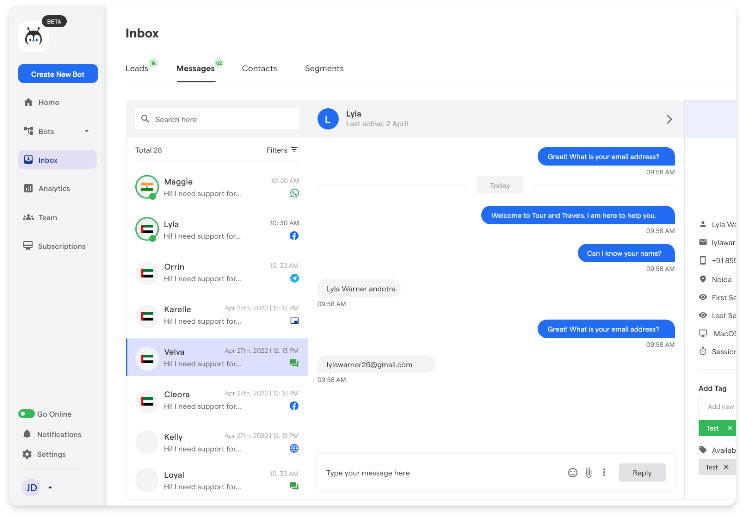
Monitor and analyze chatbot interactions to gain insights into user behavior and preferences. Use analytics tools provided by the chatbot platform to track metrics such as leads captured, conversation lengths, and user satisfaction. This data helps identify areas for improvement and optimize lead generation efforts.
Suggested Reading:
Best Practices for Chatbots in Lead Generation
Chatbots have become valuable assets in lead-generation strategies. To maximize their effectiveness, businesses must follow specific best practices to ensure personalization, prompt action, and continuous improvement. In this blog post, we will explore the key best practices for chatbots in lead generation.
Personalization and Customization
Personalization is the key to engaging potential leads and capturing their information effectively. Here are the best practices for personalizing chatbot interactions:
- Tailoring Chatbot Interactions to Users' Needs: Design chatbot conversations that cater to the specific needs and preferences of your target audience. Consider their pain points, challenges, and interests to provide relevant and helpful information. A personalized approach makes users feel valued and increases the likelihood of lead conversion.
- Incorporating User Data for Individualization: Leverage user data to personalize chatbot interactions further. Integrate chatbots with your CRM or customer database to access information about each user's previous interactions, preferences, or purchase history. This data can be used to tailor responses and offers, providing a more personalized experience.
Prompting Action and Capturing Leads
The ultimate goal of chatbots in lead generation is to prompt action and capture valuable leads. Here are the best practices for achieving this:
- Providing Clear Call-to-Actions within Chatbot Conversations: Incorporate clear and compelling call-to-actions (CTAs) within your chatbot conversations. Prompt users to take the desired action, such as signing up for a newsletter, requesting a demo, or scheduling a consultation. Use persuasive language and highlight the benefits of taking that action to encourage lead conversion.
- Designing Lead Capture Forms in an Unintrusive Manner: When requesting lead information, design lead capture forms that are easy to complete and unintrusive. Minimize the number of fields to be filled, keeping it simple and user-friendly. Consider using pre-filled fields or alternative methods like social media sign-ins to simplify the lead capture process.
Continuous Improvement and Optimization
To ensure the long-term success of chatbots in lead generation, continuous improvement and optimization are crucial. Here are the best practices for achieving this:
- Monitoring Chatbot Performance and Effectiveness: Regularly monitor chatbot performance metrics to assess its effectiveness. Track conversation completion rates, response time, user satisfaction, and conversion rates. Identify areas that need improvement and address them promptly to optimize lead generation efforts.
- Collecting Feedback and Adapting Chatbot Interactions Accordingly: Collect feedback from users regarding their experience with the chatbot. Incorporate feedback loops within chatbot conversations to gather insights and suggestions for improvement. Analyze feedback to identify common pain points or areas of confusion and make necessary adjustments to enhance user engagement and lead capture.
Generating Leads Using BotPenguin Chatbot
BotPenguin is a powerful chatbot platform that can effectively generate leads.
With its user-friendly interface and advanced features, BotPenguin simplifies the process of creating and deploying chatbots to engage with potential leads and capture their information.
Here is an overview of BotPenguin's compatibility with different platforms:
Easy Chatbot Creation and Customization
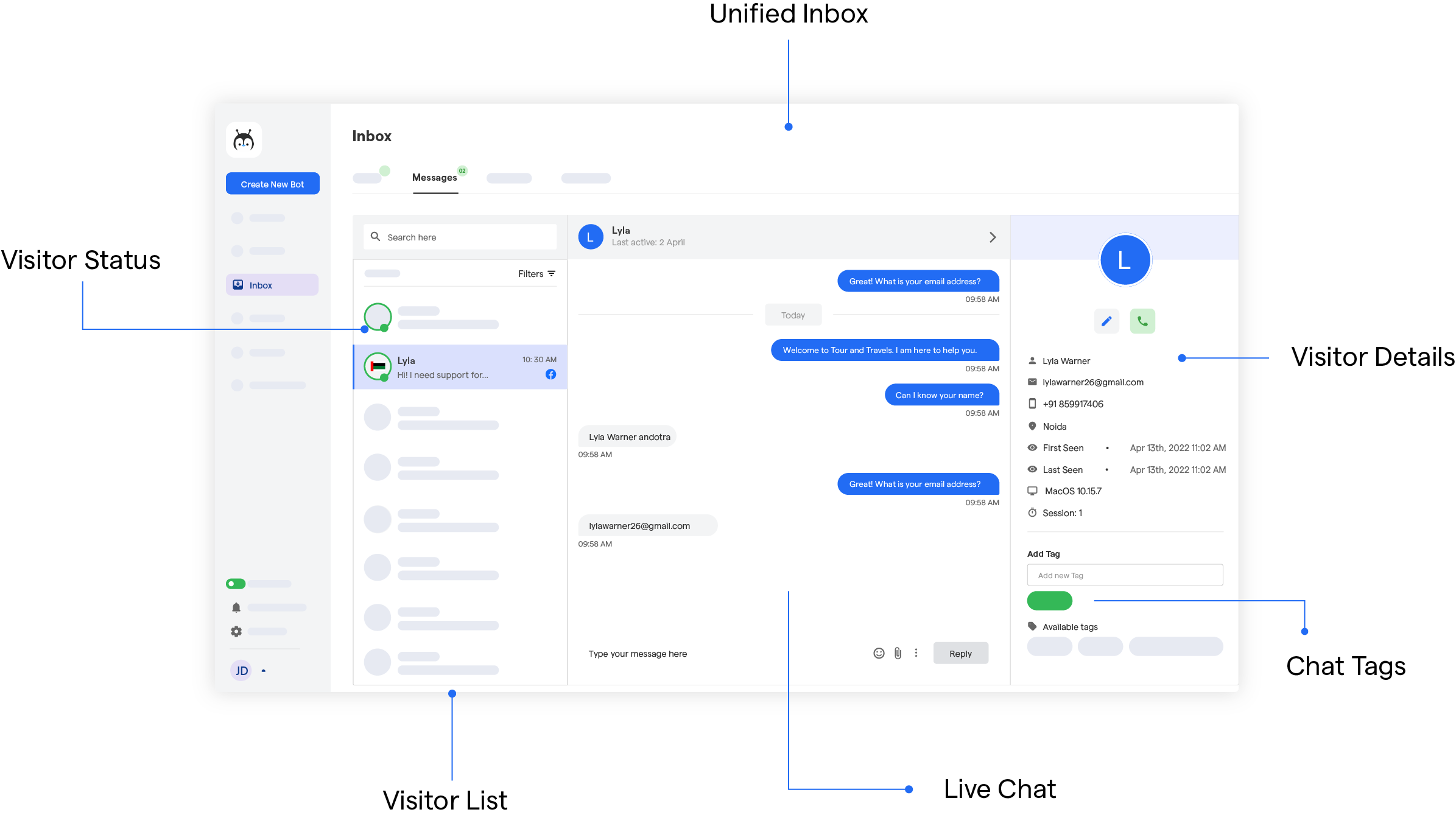
BotPenguin allows users to create custom chatbots for their businesses without any coding skills. Its user-friendly interface and pre-built templates make it easy to design conversational flows and customize the chatbot's appearance to align with your brand.
You can add various elements such as text, images, buttons, and forms to engage with visitors and capture lead information effectively.
Lead Capture Forms and Qualification
With BotPenguin, businesses can incorporate lead capture forms within the chatbot conversations. These forms can collect essential lead information such as name, email address, phone number, or any other custom fields.
The forms are designed user-friendly to minimize friction and enhance the overall user experience. Additionally, BotPenguin offers lead qualification capabilities, allowing you to define specific criteria for classifying leads and prioritizing follow-up actions.
Personalized and Interactive Conversations
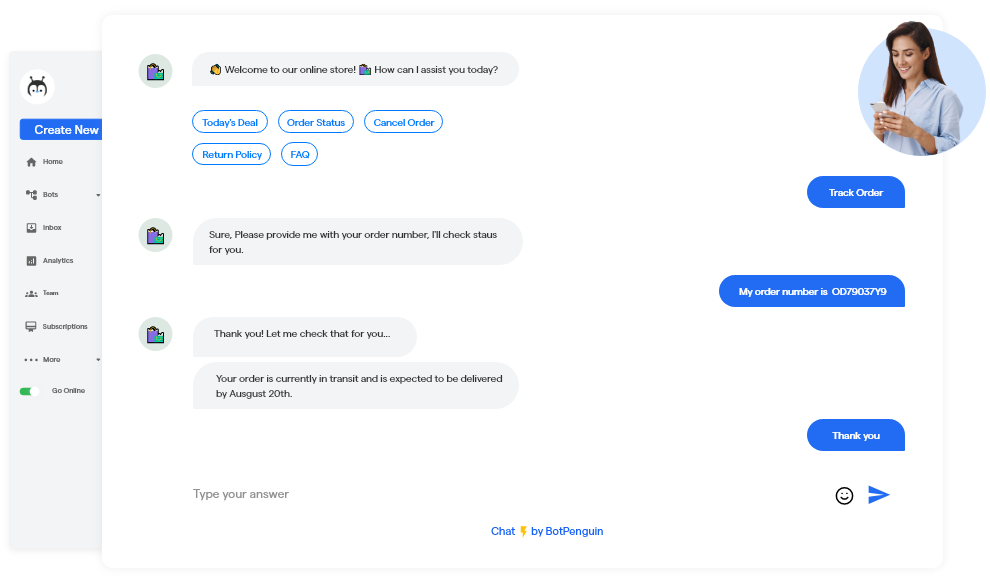
BotPenguin enables personalized chatbot interactions based on user responses and behavior. The platform offers conditional logic, dynamic content generation, and integration with external systems, enabling tailored conversations that resonate with individual leads.
By delivering personalized experiences, BotPenguin enhances engagement and increases the likelihood of lead conversion.
Multichannel Deployment
BotPenguin seamlessly integrates with popular messaging platforms such as Facebook Messenger, Telegram, and WhatsApp. This integration allows businesses to deploy custom chatbots on these platforms and engage with customers directly through messaging apps.
Additionally, BotPenguin can be integrated with websites, WordPress, Squarespace, and custom platforms, expanding the reach of chatbots and enabling businesses to engage with potential leads wherever they prefer to interact.
- WhatsApp Chatbot
- Facebook Chatbot
- WordPress Chatbot
- Telegram Chatbot
- Website Chatbot
- Squarespace Chatbot
- WooCommerce

Analytics and Optimization
To continuously improve lead generation efforts, BotPenguin provides in-depth analytics and reporting features. You can track important metrics such as conversation completion rates, user satisfaction, lead capture rates, and other key performance indicators.
These insights help identify areas for optimization and refinement, allowing you to enhance the effectiveness of your chatbot and drive better lead-generation results.
By leveraging the power of BotPenguin, businesses can create custom chatbots for various platforms, engage with potential leads, capture valuable lead information, and improve overall lead-generation efforts.
Its user-friendly interface, advanced features, and compatibility with popular messaging platforms, websites, and custom platforms make BotPenguin an ideal solution for businesses leveraging chatbots for lead generation.
Conclusion
As attention spans rapidly diminish in crowded digital spaces, harnessing conversational interfaces is pivotal for B2B lead generation success today. Early pioneers are already noting the value of 24/7 qualification and higher prospect engagement from chatbots.
With versatile functionality for lead nurturing and management, BotPenguin emerges as an ideal platform. Our chatbots spark meaningful conversations that convert by sharing helpful content, promptly answering queries, and scheduling relevant follow-ups.
Seamless CRM integrations enable capturing promising contacts and need analysis for effective sales rep hand-offs. User-friendly analytics provide visibility into conversion performance by source.
Compliance guardrails maintain data privacy across outreach campaigns. With easy customization to match the brand voice and workflows, BotPenguin makes it fast and simple to deploy engaging lead-gen chatbots.
As more competitors integrate conversational AI for growth, acting now is key. Let BotPenguin help you transform lead qualification and accelerate sales cycles through intelligent automation. Say goodbye to cold calls and generic emails - the future of B2B lead generation is conversational.
Suggested Reading:
Frequently Asked Questions (FAQs)
How can chatbots help in lead generation?
Chatbots aid lead generation by engaging prospects in real-time conversations, qualifying leads based on predefined criteria, offering personalized responses, and directing leads through the sales funnel. They efficiently gather prospect information, schedule appointments, and nurture potential customers, enhancing overall lead conversion.
Can chatbots be customized for lead generation in specific industries?
Yes, chatbots can be tailored to suit various industries. They can adapt their conversational flow, responses, and lead qualification criteria to align with the unique needs of sectors like real estate, finance, or e-commerce.
What role do AI-powered chatbots play in lead generation?
AI-powered chatbots analyze user behavior, preferences, and interactions to provide tailored responses. This technology enables more sophisticated lead qualification, leading to higher-quality prospects for businesses.
How can businesses integrate chatbots into their lead-generation strategies?
Businesses can embed chatbots on websites, social media platforms, or messaging apps. They should focus on crafting conversational experiences that guide leads through the funnel while collecting relevant data.
What is a WhatsApp chatbot for lead generation?
A WhatsApp chatbot for lead generation utilizes the WhatsApp platform to engage with users, qualify leads, provide information, and initiate interactions. These chatbots leverage WhatsApp's interface to offer personalized experiences, gather lead data, and guide potential customers toward conversion, utilizing the messaging app's wide reach for effective lead generation.

